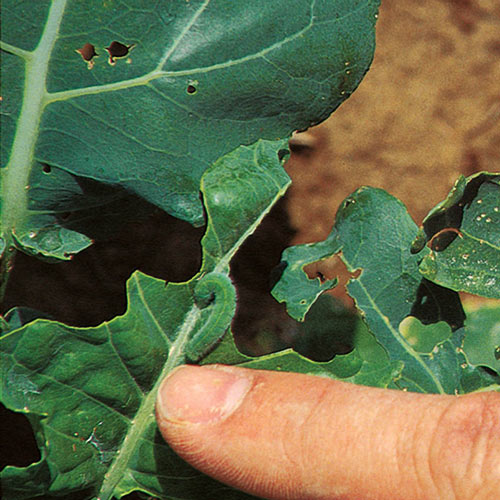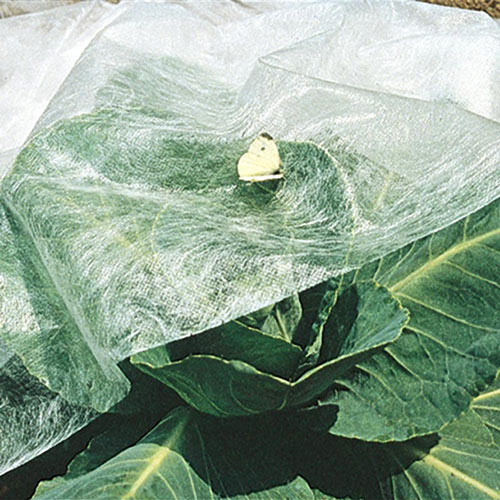Fighting Bugs, Butterflies and Slugs in Scotland
-
Helpful Products from Gardens Alive!
-
 Green Step™ II Caterpillar Control
Green Step™ II Caterpillar Control -
 Super-Lite Insect Barrier - Lightweight Row Cover
Super-Lite Insect Barrier - Lightweight Row Cover
Q. Raymond & Jennifer in Blantyre, Scotland write: "We have an allotment (kind of the UK form of American community gardening) which is generally very productive. However, we are growing more lettuce and brassicas than ever before and have problems with birds and the white cabbage butterfly. I wish to use netting, but I have made poor netting choices in the past and don't want birds caught in the net. Which size or type of netting would you suggest for effective cabbage white protection without tangling the birds?
"There are also many holes in the leaves, which is probably slug damage as we have damp climate issues. Jennifer (who is originally from Illinois) says the weather here in the West of Scotland is quite like Seattle. So slugs are our personal enemy. We use beer traps which, if Raymond doesn't drink the beer, are quite effective. The BBC Gardeners' World and the allotment society forum suggest a dense mesh, close to fleece, as the most effective control of the cabbage whites."
A. I visited the West Coast of Scotland back in the seventies and it is indeed damp, but I want to address the butterfly issue first. The vast majority of caterpillar pests are the offspring of moths, but two butterflies also come to mind. The larval form of the swallowtail likes to feed on the greenery of carrots, fennel, dill and parsley; in fact the common name of one of the little beasties (the baby Black Swallowtail) is 'the parsley worm'.
Once the baby caterpillars achieve a decent size they morph into a creature so beautiful I've never had the heart to try and control them; black and yellow on a field of green, they're second only to the monarch caterpillar in good looks. The big ones can also be prompted to display a cool trick; when threatened they can pop a specialized organ called the osmeterium out of the back of their head; a spike-like thing coated with noxious chemicals that smells "like rancid butter". Fun for the entire family!!
And of course, the butterflies they become are drop dead gorgeous.
The cabbage white has nothing going for it. It's a drab butterfly that gives birth to the {quote} "cabbage worm"; a nasty piece of work whose green color blends in perfectly with the crops it's devouring.
And our Scottish couple have been given sound advice on a prime deterrent, although the terminology is a little different than in the US. They don't want any kind of bird netting', not only because of the tangle angle but because birds are excellent predators of pest caterpillars. Smart gardeners provide nesting boxes and birdbaths near threatened plants and avoid artificial bird feeding outside of winter. You don't want your birds to fill up on seed instead of cabbage worms!
Entomology Note: Although the term 'worm' is applied to a huge number of agricultural pests (tomato hornworm, cutworm, corn earworm, etc.), all are caterpillars, not worms of any kind.
Anyway, a cover of "fleece" sounds like what we here on the other side of The Pond call 'floating row cover'. It's a light breathable fabric that creates an excellent barrier against egg laying and similar attacks. As a bonus, it also increases the growth rate of plants in chilly areas, and it can be used on any crop that doesn't flower--like all of the brassicas that this pest attacks.
There's also the original strain of Bt for caterpillar control. You spray this naturally occurring soil organism on a plant and any caterpillar that chews on the sprayed leaves will stop feeding and die. Bt harms NOTHING else; not birds, bees, frogs, toads or even adult butterflies (because they're not feeding). I couldn't find any information on its availability in Europe, but if I had cabbage white problems, I'd try and seek it out.
And then we have the slimy slug; the first pest to consider when plants are eaten overnight. Beer traps can be very effective, but the beer must be fresh, poured into its containers at sunset. Cheap beer is fine, but I never saw any during my travels in England, Scotland or Wales, where the 'worst' beer always seemed to be equal to America's best.
Again, we have a great non-toxic slug control in the States, but I'm unsure if its available in Europe. Sold under the brand name Sluggo, it's little pellets of yeast laced with iron phosphate. The slugs go for the yeast and the iron does them in. And, as we mentioned a few shows ago, copper barriers can also be very effective.
And now I digress.
After that show, we were challenged by Andrea in Brighton, Michigan ("West of Detroit, north of Ann Arbor") who writes: "You say that copper causes slugs to get electrocuted. From a chemical/physics perspective, how is the electricity that zaps the creatures generated?"
We found the answer in a post by Biomedical scientist Chris Bland. And we quote: "Copper reacts with the slime that covers slugs, resulting in an unpleasant electro-neural signal similar to an electrical shock...[the] slime is mostly water with dissolved proteins, glycoproteins and metal ions...Since neuron action potentials are often regulated by fluctuations in metal ion concentrations across neuronal membranes...it makes sense that copper ions may induce ...painful...stimuli."
Special thanks to entomologist Dr. Michael Raupp, "The Bug Guy" for all the cool swallowtail info I lifted from his exceptional website without his knowledge. I said "exceptional" Mike, so please don't sue me.
"There are also many holes in the leaves, which is probably slug damage as we have damp climate issues. Jennifer (who is originally from Illinois) says the weather here in the West of Scotland is quite like Seattle. So slugs are our personal enemy. We use beer traps which, if Raymond doesn't drink the beer, are quite effective. The BBC Gardeners' World and the allotment society forum suggest a dense mesh, close to fleece, as the most effective control of the cabbage whites."
A. I visited the West Coast of Scotland back in the seventies and it is indeed damp, but I want to address the butterfly issue first. The vast majority of caterpillar pests are the offspring of moths, but two butterflies also come to mind. The larval form of the swallowtail likes to feed on the greenery of carrots, fennel, dill and parsley; in fact the common name of one of the little beasties (the baby Black Swallowtail) is 'the parsley worm'.
Once the baby caterpillars achieve a decent size they morph into a creature so beautiful I've never had the heart to try and control them; black and yellow on a field of green, they're second only to the monarch caterpillar in good looks. The big ones can also be prompted to display a cool trick; when threatened they can pop a specialized organ called the osmeterium out of the back of their head; a spike-like thing coated with noxious chemicals that smells "like rancid butter". Fun for the entire family!!
And of course, the butterflies they become are drop dead gorgeous.
The cabbage white has nothing going for it. It's a drab butterfly that gives birth to the {quote} "cabbage worm"; a nasty piece of work whose green color blends in perfectly with the crops it's devouring.
And our Scottish couple have been given sound advice on a prime deterrent, although the terminology is a little different than in the US. They don't want any kind of bird netting', not only because of the tangle angle but because birds are excellent predators of pest caterpillars. Smart gardeners provide nesting boxes and birdbaths near threatened plants and avoid artificial bird feeding outside of winter. You don't want your birds to fill up on seed instead of cabbage worms!
Entomology Note: Although the term 'worm' is applied to a huge number of agricultural pests (tomato hornworm, cutworm, corn earworm, etc.), all are caterpillars, not worms of any kind.
Anyway, a cover of "fleece" sounds like what we here on the other side of The Pond call 'floating row cover'. It's a light breathable fabric that creates an excellent barrier against egg laying and similar attacks. As a bonus, it also increases the growth rate of plants in chilly areas, and it can be used on any crop that doesn't flower--like all of the brassicas that this pest attacks.
There's also the original strain of Bt for caterpillar control. You spray this naturally occurring soil organism on a plant and any caterpillar that chews on the sprayed leaves will stop feeding and die. Bt harms NOTHING else; not birds, bees, frogs, toads or even adult butterflies (because they're not feeding). I couldn't find any information on its availability in Europe, but if I had cabbage white problems, I'd try and seek it out.
And then we have the slimy slug; the first pest to consider when plants are eaten overnight. Beer traps can be very effective, but the beer must be fresh, poured into its containers at sunset. Cheap beer is fine, but I never saw any during my travels in England, Scotland or Wales, where the 'worst' beer always seemed to be equal to America's best.
Again, we have a great non-toxic slug control in the States, but I'm unsure if its available in Europe. Sold under the brand name Sluggo, it's little pellets of yeast laced with iron phosphate. The slugs go for the yeast and the iron does them in. And, as we mentioned a few shows ago, copper barriers can also be very effective.
And now I digress.
After that show, we were challenged by Andrea in Brighton, Michigan ("West of Detroit, north of Ann Arbor") who writes: "You say that copper causes slugs to get electrocuted. From a chemical/physics perspective, how is the electricity that zaps the creatures generated?"
We found the answer in a post by Biomedical scientist Chris Bland. And we quote: "Copper reacts with the slime that covers slugs, resulting in an unpleasant electro-neural signal similar to an electrical shock...[the] slime is mostly water with dissolved proteins, glycoproteins and metal ions...Since neuron action potentials are often regulated by fluctuations in metal ion concentrations across neuronal membranes...it makes sense that copper ions may induce ...painful...stimuli."
Special thanks to entomologist Dr. Michael Raupp, "The Bug Guy" for all the cool swallowtail info I lifted from his exceptional website without his knowledge. I said "exceptional" Mike, so please don't sue me.
-
Helpful Products from Gardens Alive!
-
 Green Step™ II Caterpillar Control
Green Step™ II Caterpillar Control -
 Super-Lite Insect Barrier - Lightweight Row Cover
Super-Lite Insect Barrier - Lightweight Row Cover







 Gardens Alive! & Supplies
Gardens Alive! & Supplies




